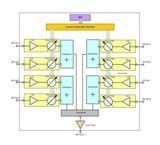
-
StatusCompleted
-
Status date2015-04-13
-
Activity Code5C.083
Direct radiating antennas (DRA) and semi active reflector based antennas are currently being considered for the implementation of reconfigurable payloads and mobile terminals. Both applications require Beam Forming Networks (BFN), integrating a very high number of phase and amplitude control MMICs with the associated digital control electronics.
Current SiGe MMIC technology allows the design of multinode MMICs integrating more than one beam-forming node on the same chip. The technology also allows the integration of mixed analogue/digital functions on the same chip, thus significantly reducing the complexity, part count, yield and overall cost of BFNs.
The activity has two objectives:
- The design, manufacture and testing of an EM for a Ku band BFN module, based on a multinode on chip implementation using a European MMIC process. This module shall be functionally, technologically, electrically and mechanically representative of future on board implementations.
- The design, manufacture and testing of a multinode MMIC for use in future Ku band phased array mobile terminals.
Multifuctional integrated MMIC represents key components of the future antenna BFN, allowing the minimization of the interconnections and the simplification of both the digital and RF circuitry.
The main challenges are to design an MMICs with a very precise phase control (for both User-Terminal and On-Board) and a linear in dB gain control (On-Board).
Phase and Gain controls actuation on each RF arm is managed with a circuital solution that takes advantage of both Bipolar and MOS available transistors, which are meant to face process yield variation allowing additional resolution control bits to tune the BFN coefficient value.
In order to allow the services to spread rapidly, a key factor is the identification of enabling technologies for a low-cost user terminal antenna system. Mobile and portable terminals, in particular, will require good performance in terms of gain and the capability of tracking the satellite. Thinking of a phased array antenna implementation, a non negligible cost factor will be the integration of the MMIC in the BFN and, considering mass production, solutions aimed at minimizing this cost can represent the real challenge.
In this respect, multifunctional MMICs can jointly provide good performances and integrated functionalities, so reducing the overall complexity of the system, the number of components to be integrated and the number of connections from the digital to the RF part. A first step in this direction is the GaAs Digital Vector Modulator integrating a phase shifter, an attenuator and a serial to parallel converter. Looking at GaAs technology, SiGe technology allows an higher integration and it is possible to have more than a channel in a single MMIC.
High accuracy TX Bean Former, with a lower need for calibration since phase change due to gain control is quite small.
User Terminal MMIC:
The designed IC includes 8 receiver channels of a BFN structure: each channel includes a digitally-controlled phase shifter, and the signal resulting from the sum of all the channels is provided at the output of the IC. Each channel includes a front-end LNA, to guarantee the desired noise figure, followed by a phase shifter. To better exploit the characteristics of the SiGe technology, a vector modulator approach is adopted as the better architecture for the phase shifter.
Differential signaling is used to minimize the effect of common-mode noise and disturbances and to extend the dynamic range, therefore the LNA has also to provide single-ended to differential conversion.
User Terminal Architecture
On Board MMIC:
The TX Beam Forming Network MMIC is 1 RF input to 4 RF independent output, with a nominal gain for each arm equal to 7dB. The TX BFN MMIC is equipped with an SPI interface that allows digitally setting gain and phase through 5bits and 6 bits control words respectively, independently on each arm. The gain is controllable in 0.5dB steps for a nominal gain control range of 0 to -15.5 dB while phase is settable in 5.625° steps to cover the entire 360° rotation.
The MMIC may be clustered as 4 devices in a single substrate to provide a global 1 input to 16 independent outputs with a nominal 0dB gain.
The plan will focus on the following points:
- Correction on the layout for the final foundry run, based on tests results;
- Tests on final MMICs;
- Test and Final Review.
The project has been divided in two Phases: a requirement analysis and detailed design Phase. A MAIT phase where two IHP Foundry runs have been planned.
The project is now finished.





